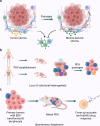Patient-derived xenograft models in cancer therapy: technologies and applications
- PMID: 37045827
- PMCID: PMC10097874
- DOI: 10.1038/s41392-023-01419-2
Patient-derived xenograft models in cancer therapy: technologies and applications
Abstract
Patient-derived xenograft (PDX) models, in which tumor tissues from patients are implanted into immunocompromised or humanized mice, have shown superiority in recapitulating the characteristics of cancer, such as the spatial structure of cancer and the intratumor heterogeneity of cancer. Moreover, PDX models retain the genomic features of patients across different stages, subtypes, and diversified treatment backgrounds. Optimized PDX engraftment procedures and modern technologies such as multi-omics and deep learning have enabled a more comprehensive depiction of the PDX molecular landscape and boosted the utilization of PDX models. These irreplaceable advantages make PDX models an ideal choice in cancer treatment studies, such as preclinical trials of novel drugs, validating novel drug combinations, screening drug-sensitive patients, and exploring drug resistance mechanisms. In this review, we gave an overview of the history of PDX models and the process of PDX model establishment. Subsequently, the review presents the strengths and weaknesses of PDX models and highlights the integration of novel technologies in PDX model research. Finally, we delineated the broad application of PDX models in chemotherapy, targeted therapy, immunotherapy, and other novel therapies.
© 2023. The Author(s).
Conflict of interest statement
The authors declare no competing interests.
Figures





Similar articles
-
Establishment of a high-fidelity patient-derived xenograft model for cervical cancer enables the evaluation of patient's response to conventional and novel therapies.J Transl Med. 2023 Sep 9;21(1):611. doi: 10.1186/s12967-023-04444-5. J Transl Med. 2023. PMID: 37689699 Free PMC article.
-
Application of Highly Immunocompromised Mice for the Establishment of Patient-Derived Xenograft (PDX) Models.Cells. 2019 Aug 13;8(8):889. doi: 10.3390/cells8080889. Cells. 2019. PMID: 31412684 Free PMC article. Review.
-
Representation of genomic intratumor heterogeneity in multi-region non-small cell lung cancer patient-derived xenograft models.Nat Commun. 2024 May 31;15(1):4653. doi: 10.1038/s41467-024-47547-3. Nat Commun. 2024. PMID: 38821942 Free PMC article.
-
Establishment and evaluation of retroperitoneal liposarcoma patient-derived xenograft models: an ideal model for preclinical study.Int J Med Sci. 2022 Jul 11;19(8):1241-1253. doi: 10.7150/ijms.70706. eCollection 2022. Int J Med Sci. 2022. PMID: 35928724 Free PMC article.
-
Patient-derived xenograft (PDX) models, applications and challenges in cancer research.J Transl Med. 2022 May 10;20(1):206. doi: 10.1186/s12967-022-03405-8. J Transl Med. 2022. PMID: 35538576 Free PMC article. Review.
Cited by
-
Patient-Derived Models of Cancer in the NCI PDMC Consortium: Selection, Pitfalls, and Practical Recommendations.Cancers (Basel). 2024 Jan 29;16(3):565. doi: 10.3390/cancers16030565. Cancers (Basel). 2024. PMID: 38339316 Free PMC article. Review.
-
Need for Ethical Governance on the Implementation and Use of Patient-derived Xenograft (PDX) Models for Anti-cancer Drug Discovery and Development: Ethical Considerations and Policy Proposal.JMA J. 2024 Oct 15;7(4):605-609. doi: 10.31662/jmaj.2023-0199. Epub 2024 Aug 9. JMA J. 2024. PMID: 39513080 Free PMC article.
-
A Novel Microfluidic Platform for Personalized Anticancer Drug Screening Through Image Analysis.Micromachines (Basel). 2024 Dec 21;15(12):1521. doi: 10.3390/mi15121521. Micromachines (Basel). 2024. PMID: 39770275 Free PMC article.
-
Correspondence to editorial on "UBE2S promotes glycolysis in hepatocellular carcinoma by enhancing E3 enzyme-independent polyubiquitination of VHL".Clin Mol Hepatol. 2025 Jan;31(1):e58-e60. doi: 10.3350/cmh.2024.0590. Epub 2024 Jul 29. Clin Mol Hepatol. 2025. PMID: 39069722 Free PMC article. No abstract available.
-
From DNA-Encoded Library Screening to AM-9747: An MTA-Cooperative PRMT5 Inhibitor with Potent Oral In Vivo Efficacy.J Med Chem. 2025 Mar 27;68(6):6534-6557. doi: 10.1021/acs.jmedchem.4c03101. Epub 2025 Mar 18. J Med Chem. 2025. PMID: 40102181 Free PMC article.
References
Publication types
MeSH terms
LinkOut - more resources
Full Text Sources
Other Literature Sources
Medical

